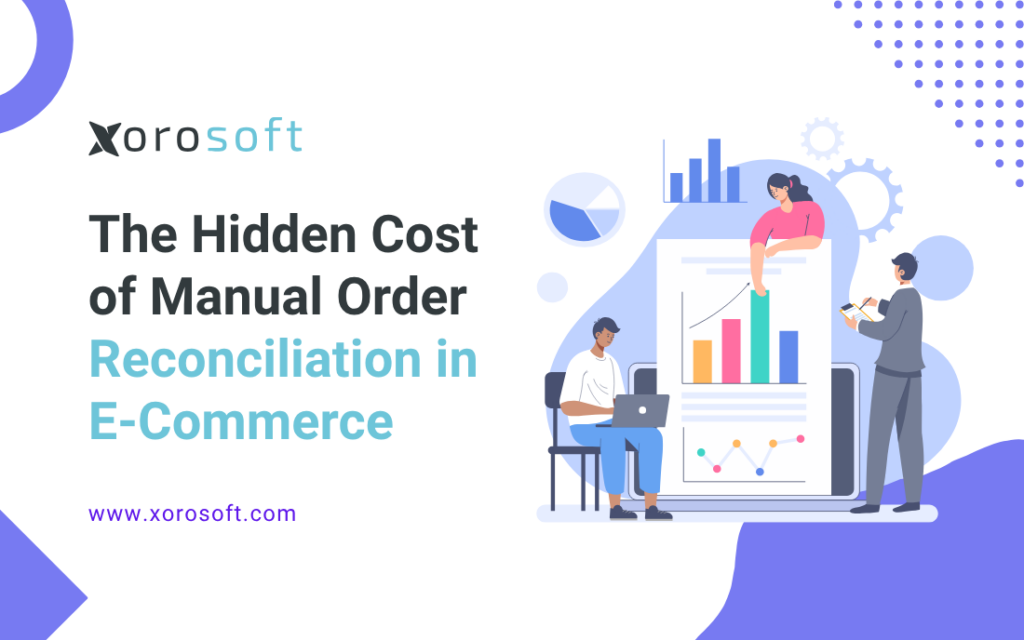
Order Reconciliation Automation for Seamless E-Commerce Growth
Running an ecommerce business is exciting; however, it often becomes messy behind the scenes. Most founders don’t realize how much time their teams lose reconciling orders manually. Thankfully, order reconciliation automation can solve that problem quickly. When reconciliation runs automatically, you save hours every week, improve accuracy, and gain a real-time view of cash flow.
As your sales volume grows, manual work becomes harder to manage. Consequently, automation is no longer optional — it’s a necessity for sustainable growth. Moreover, automated reconciliation ensures accuracy even as complexity increases.
Why Manual Order Reconciliation Creates Hidden Bottlenecks
Manual reconciliation seems simple at first glance; nevertheless, it becomes chaotic as your business scales. Each additional marketplace, discount, or return adds complexity. Moreover, because tools like Shopify, accounting software, and fulfillment systems don’t communicate seamlessly, teams must constantly double-check figures.
As a result, errors creep in, and operational confidence declines. Therefore, embracing order reconciliation automation helps you eliminate the need for constant manual reviews and late-night corrections. Furthermore, automation fosters accuracy, accountability, and speed.
Common Pain Points Before Order Reconciliation Automation
Although every ecommerce operation is unique, several recurring challenges appear consistently. For instance, the same workflow gaps affect most growing brands:
-
Disconnected systems: Shopify, warehouses, and accounting platforms often show conflicting numbers. Consequently, teams waste time verifying data.
-
Spreadsheet overload: Because data exports are handled manually, every edit introduces potential mistakes. In addition, cross-checking consumes hours.
-
Data mismatches: Returns and discounts often distort inventory and revenue records. Therefore, reconciling becomes exhausting.
-
Delayed payments: When invoices lag behind, cash flow tightens. As a result, forecasting accuracy declines.
-
Fulfillment errors: Mismatched data causes double shipments or incorrect charges.
However, once you switch to automated order reconciliation, these issues fade almost immediately. In other words, automation prevents chaos before it starts.
The Financial Impact of Manual Reconciliation
The hidden cost of manual reconciliation is enormous, even if it doesn’t appear on your P&L statement. Moreover, lost time and delayed decisions create ripple effects that stunt growth. Consequently, every minute of manual work reduces profit potential.
| Hidden Cost | Effect | Estimated Monthly Loss |
|---|---|---|
| Lost team hours | 20–40 hours weekly | $1,000–$3,000 |
| Slow cash flow | 7–14 days delay | $5,000–$20,000 |
| Refund mistakes | 1–3% of revenue | $2,000–$8,000 |
| Missed insights | Poor forecasting | Hard to measure |
In contrast, order reconciliation automation connects your systems in real time, reducing inefficiencies dramatically. As a result, finance and operations stay aligned at all times.
How Order Reconciliation Automation Improves Accuracy and Speed
Automation does more than save time — it transforms how your business operates. Because data flows instantly between systems, accuracy increases while stress decreases. Furthermore, reports become easier to generate, and teams trust their data.
Here’s what automation delivers:
1. Instant synchronization: Orders, refunds, and invoices update automatically. Consequently, your team never needs to rekey data.
2. Error prevention: Automated alerts highlight mismatches before they snowball. Additionally, review cycles become faster.
3. Faster closing: Month-end reports become quick and reliable. Moreover, management gains confidence in numbers.
4. Cash visibility: Payments reconcile instantly, boosting liquidity and predictability.
5. Scalability: As your business grows, processes remain consistent. Therefore, teams can focus on strategy instead of spreadsheets.
Thus, automation builds trust and enables leaders to make real-time decisions confidently.
Case Study: Success with Automated Order Reconciliation
Consider a $6M fashion brand that relied heavily on spreadsheets to reconcile Shopify, QuickBooks, and ShipStation data. Each week, the team spent 25 hours fixing mismatches. However, reports still came in late.
After implementing order reconciliation automation, the transformation was remarkable. As a result:
-
Daily reconciliations completed automatically overnight.
-
Accuracy rose to 98.7%.
-
Cash conversion cycle improved by six days.
-
The team recovered 20+ hours weekly.
Therefore, the COO could finally focus on growth rather than maintenance. In short, automation unlocked time, accuracy, and calm.
Step-by-Step Plan to Implement Order Reconciliation Automation
Transitioning from manual work to automation may feel daunting at first. However, with a clear roadmap, the process becomes surprisingly easy. Furthermore, every improvement pays back almost instantly.
Step 1 – Analyze Existing Reconciliation Workflows
Start by mapping every system involved in order processing. Consequently, you’ll uncover where time and accuracy are being lost. Additionally, this audit clarifies which integrations deliver the fastest ROI.
Goal: Identify bottlenecks.
Metric: Manual steps documented.
Step 2 – Standardize and Prepare Data for Automation
Before integrating, ensure consistent SKUs, prices, and naming conventions. Furthermore, cleaning your data prevents automation errors later. In addition, standardization simplifies communication across systems.
Goal: Ensure data quality.
Metric: SKUs standardized across systems.
Step 3 – Integrate Systems Using Order Reconciliation Automation Tools
Use order reconciliation automation platforms such as Xorosoft ERP for Shopify. These solutions connect Shopify, accounting, and fulfillment seamlessly. Consequently, information updates in real time across departments.
Goal: Create real-time synchronization.
Metric: Orders synced per day.
Step 4 – Automate Routine Reconciliation Tasks for Efficiency
Set up rules for invoicing, matching, and reporting. In addition, include notifications to flag exceptions. Consequently, your team can focus on strategy instead of repetition. Likewise, automation strengthens consistency across teams.
Goal: Save time and reduce stress.
Metric: Weekly hours saved.
Step 5 – Optimize and Monitor Performance Regularly
After automation goes live, measure improvements monthly. Moreover, refine workflows as new channels or SKUs are added. Therefore, optimization ensures continued accuracy and scalability.
Goal: Continuous improvement.
Metric: Accuracy rate and speed.
Five-Day Implementation Framework for Automation
| Day | Focus | Action | Outcome |
|---|---|---|---|
| Day 1 | Audit | Identify data gaps | Visibility |
| Day 2 | Data cleanup | Align SKUs | Standardization |
| Day 3 | Integration | Connect systems | Real-time sync |
| Day 4 | Automation | Enable workflows | 50% time saved |
| Day 5 | Optimization | Test and adjust | Reliable automation |
Meanwhile, communication with your team is vital during rollout. Consequently, everyone stays aligned and confident in the process.
How to Measure the ROI of Order Reconciliation Automation
Tracking progress helps justify the investment. Therefore, focus on these metrics for ongoing insight.
-
Order accuracy: Should rise above 95%.
-
Reconciliation time: Should drop from days to hours.
-
Cash conversion cycle: Should shorten noticeably.
Additionally, faster reconciliation improves financial forecasting, supplier relations, and customer satisfaction. Moreover, consistency across reports boosts leadership confidence.
Why Order Reconciliation Automation Fuels Long-Term Growth
Manual reconciliation limits how far your brand can scale. However, automation provides the structure needed for sustainable expansion. Moreover, automation strengthens collaboration between finance and operations.
With order reconciliation automation, your financial data becomes reliable, your team gains focus, and your decisions become faster. Likewise, automated systems reduce dependency on key individuals.
For tested solutions, check G2’s ERP rankings or explore Xorosoft ERP for Shopify for ready-to-use integrations.
Automate Your Reconciliation and Focus on Growth
Reconciliation shouldn’t steal your team’s creativity. Instead, automation delivers accuracy, transparency, and calm operations.
Because growth thrives on reliable data, now is the best time to automate.
👉 Book a demo to see how automation transforms your finance workflows, or Explore XoroONE — the unified platform designed for complete operational clarity.









